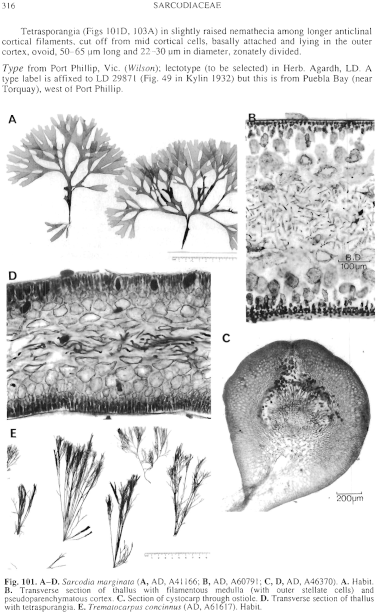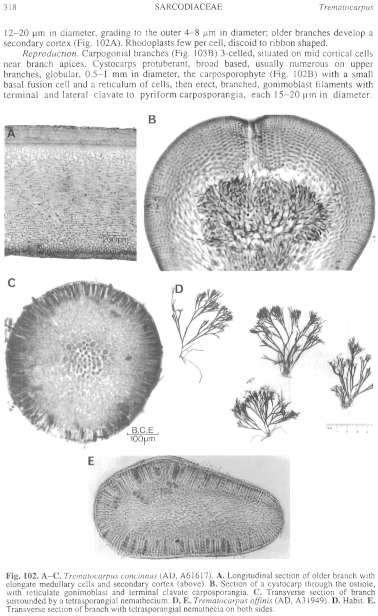|
|
|
|
|
|||||||||||
|
Electronic Flora of South Australia Species Fact Sheet
Phylum Rhodophyta – Class Florideophyceae – Order Gigartinales – Family Sarcodiaceae
Synonyms
Fucus concinnus R. Brown ex Turner 1811: pl. 153.
Sphaerococcus concinnus (R. Brown ex Turner)C. Agardh 1822: 312; 1824: 234.
Dicurella concinna (R. Brown ex Turner)J. Agardh 1852: 631; 1876: 406.
Hypnea furcellata Hooker & Harvey 1847: 405.
Dicranema furcellatum (Hooker & Harvey) Harvey 1859b: 313; 1863, synop. :xxxiii. J. Agardh 1852: 635. Kützing 1869: 14, pl. 38c-e.
Thallus (Fig. 101E) medium to dark red-brown, fading to yellow-red, 4–15 cm high, subdichotomously (tending to be complanately) branched at intervals of 1–3 cm, occasionally proliferous above, branch angles usually 30°-60°, branches terete to slightly compressed, 400–600 (–800) µm broad, linear and only slightly tapering to the rounded apices. Holdfast crustose, 1–5 mm across, with several fronds; epilithic. Structure (Fig. 102A, C) of a compact medulla of longitudinally elongate cells, 10–20 µm in diameter and L/D 6–10, with a compact pseudoparenchymatous cortex of ovoid cells, the inner ones 12–20 µm in diameter, grading to the outer 4–8 µm in diameter; older branches develop a secondary cortex (Fig. 102A). Rhodoplasts few per cell, discoid to ribbon shaped.
Reproduction: Carpogonial branches (Fig. 103B) 3-celled, situated on mid cortical cells near branch apices. Cystocarps protuberant, broad based, usually numerous on upper branches, globular, 0.5–1 mm in diameter, the carposporophyte (Fig. 102B) with a small basal fusion cell and a reticulum of cells, then erect, branched, gonimoblast filaments with terminal and lateral clavate to pyriform carposporangia, each 15–20 1.1.m in diameter.
Type from Kent Is, Bass Strait (R. Brown); holotype in BM.
Selected specimens: Cape Northumberland, S. Aust., uppermost sublittoral (Wornersley, 24.ii.1992; AD, A61617 -"Marine Algae of southern Australia" No. 364). Bridgewater Bay, Vic., drift (Beauglehole, 17.vii.1949; AD, Al2096). Lawrence Rock, off Portland, Vic., in pools (Beauglehole, 13.i.1954; AD, A20519 and 15.i.1960; AD, A24797). Bicheno, Tas., upper sublittoral (Wollaston, 11.viii.1965; AD, A29583). Wineglass Bay, Freycinet Pen., Tas., upper sublittoral pools (Wollaston & Mitchell, 2.iii.1964; AD, A27909). Tesselated Pavement, Eaglehawk Neck, Tas., upper sublittoral (Gordon, 13.i.1966; AD, A30085). Fluted Cape, Bruny I., Tas., 23 m deep (Shepherd, 12.ii.1972; AD, A41915).
Distribution: Cape Northumberland, S. Aust., to Bridgewater Bay, Vic., Kent Is, and the east coast of Tasmania.
Taxonomic notes: Pericarp (Fig. 102B) massive, 200–250 µm thick, ostiolate. Spermatangia (Fig. 103C) cut off from surface cortical cells in short chains, ovoid, 2–3 µm in diameter.
Tetrasporangial nemathecia (Fig. 102C) largely covering ultimate short branchlets (often proliferous), with short anticlinal paraphyses 2–3 cells and 50–60 µm long and ovoid tetrasporangia (Fig. 103D) 40–55 µm long and 14–22 µm in diameter, zonately divided.
Brown's specimens in BM (2 specimens on one sheet, with "Turn. tab. 153" on it), and Turner's illustration of Trematocarpus concinnus are distinct from Melanthalia concinna J. Agardh (see under the latter species), which differs in having more compressed branches, branch apices with terminal collars, distinctly shorter and more ovoid medullary cells, different carposporophyte structure and cruciately divided tetrasporangia.
T. concinnus is very similar to the South African T. fragilis (C. Agardh) De Toni in habit and structure, but differs in having terminal, clavate, carposporangia in contrast to the chains of small carposporangia in the latter (see Searles 1968, fig. 32).
References:
AGARDH, C.A. (1822). Species Algarum. Vol. 1, Part 2, pp. 169–398. (Berling: Lund.)
AGARDH, C.A. (1824). Systema Algarum. (Berling: Lund.)
AGARDH, J.G. (1852). Species Genera et Ordines Algarum. Vol. 2, Part 2, pp. 337–720. (Gleerup: Lund.)
AGARDH, J.G. (1876). Species Genera et Ordines Algarum. Vol. 3, Part 1 - Epicrisis systematis Floridearum, pp. i-vii, 1–724. (Weigel: Leipzig.)
DE TONI, G.B. (1900). Sylloge Algarum omnium hucusque Cognitarum. Vol. 4. Florideae. Sect. 2, pp. 387–776. (Padua.)
HARVEY, W.H. (1859b). Algae. In Hooker, J.D., The Botany of the Antarctic Voyage. Flora Tasmaniae. Vol. II, pp. 282–320.
HARVEY, W.H. (1863). Phycologia Australica. Vol. 5, Plates 241–300, synop., pp. i-lxxiii. (Reeve: London.)
HOOKER, J.D. & HARVEY, W.H. (1847). Algae Tasmanicae. Lond. J. Bot. 6, 397–417.
KÜTZING, F.T. (1869). Tabulae Phycologicae. Vol. 19. (Nordhausen.)
SEARLES, R.B. (1968). Morphological studies of red algae of the order Gigartinales. Univ. Calif Pubis Bot. 43, vi + 1–86, Plates 1–12.
TURNER, D. (1811). Fuci sive Plantarum Fucorum Generi a Botanicis Ascriptarum Icones Descriptiones et Historia. Vol. 3, pp. 1–148, Plates 135–196. (London.)
The Marine Benthic Flora of Southern Australia Part IIIA complete list of references.
Publication:
Womersley, H.B.S. (14 January, 1994)
The Marine Benthic Flora of Southern Australia
Rhodophyta. Part IIIA, Bangiophyceae and Florideophyceae (to Gigartinales)
Reproduced with permission from The Marine Benthic Flora of Southern Australia Part IIIA 1994, by H.B.S. Womersley. Australian Biological Resources Study, Canberra. Copyright Commonwealth of Australia.
Illustrations in Womersley Part IIIA, 1994: FIGS 101E, 102 A–C, 103 B–D.

Figure 101 enlarge
Fig. 101. A–D. Sarcodia marginata (A, AD, A41166; B, AD, A60791; C, D, AD, A46370). A. Habit. B. Transverse section of thallus with filamentous medulla (with outer stellate cells) and pseudoparenchymatous cortex. C. Section of cystocarp through ostiole. D. Transverse section of thallus with tetrasporangia. E. Trematocarpus concinnus (AD, A61617). Habit.

Figure 102 enlarge
Fig. 102. A–C. Trematocarpus concinnus (AD, A61617). A. Longitudinal section of older branch with elongate medullary cells and secondary cortex (above). B. Section of a cystocarp through the ostiole, with reticulate gonimoblast and terminal clavate carposporangia. C. Transverse section of branch surrounded by a tetrasporangial nemathecium. D, E. Trematocarpus affinis (AD, A31949). D. Habit. E. Transverse section of branch with tetrasporangial nemathecia on both sides.

Figure 103 enlarge
Fig. 103. A. Sarcodia marginata (AD, A24453). Transverse section of cortex with tetrasporangia. B–D. Trematocarpus concinnus (AD, A61617). B. Cortical filaments with a 3-celled carpogonial branch. C. Cortical filaments with spermatangial chains. D. Cortical filaments with tetrasporangia. E. Trematocarpus affinis (AD, A31949). Cortical filaments with tetrasporangia. F–J. Dicranema revolutum (AD, A38408). F. Branch ends with cystocarps. G. Terminal branches with tetrasporangial nemathecia. H. Longitudinal section of branch apex. I. Transverse section of branch with medullary core and large inner cortical cells. J. Cortex with deep-seated carpogonial branches. [F–J after Kraft 1977b.]

|
Email Contact: State Herbarium of South Australia |

|